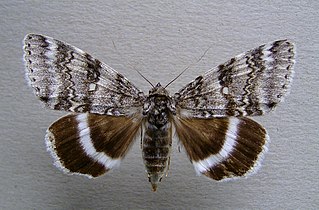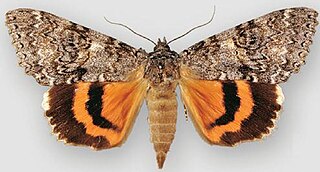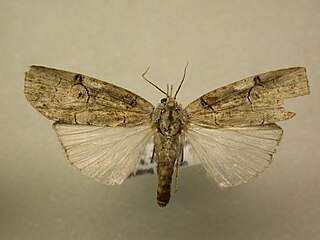Sir George Francis Hampson, 10th Baronet was an English entomologist.

In zoology and botany, a paratype is a specimen of an organism that helps define what the scientific name of a species and other taxon actually represents, but it is not the holotype. Often there is more than one paratype. Paratypes are usually held in museum research collections.

Craniophora ligustri, the coronet, is a moth of the family Noctuidae. The species was first described by Michael Denis and Ignaz Schiffermüller in 1775. It is found in Europe, through the Palearctic to Japan.

Paratype is a genus of moths in the subfamily Arctiinae first described by Felder in 1874. They are found in the Neotropics.

Lymantria is a genus of tussock moths in the family Erebidae. They are widely distributed throughout Europe, Japan, India, Sri Lanka, Myanmar, Java, and Celebes. The genus was erected by Jacob Hübner in 1819.

Catocala relicta, the white underwing or relict, is a moth of the family Erebidae. The species was first described by Francis Walker in 1858. It lives in southern Canada, from Newfoundland to Vancouver Island, south to Missouri, and Arizona.

Catocala unijuga, the once-married underwing, is a moth of the family Erebidae. The species was first described by Francis Walker in 1858. It is found in North America from Newfoundland west to south central British Columbia, south to Kentucky and Missouri in the east, Colorado and Utah in the west.

Iscadia is a genus of moths of the family Nolidae. The genus was erected by Francis Walker in 1857.
Lambula nigra is a moth of the family Erebidae. It was described by van Eecke in 1929. It is found on Buru.
Macroptila elongata is a moth of the subfamily Arctiinae. It was described by Reich in 1936. It is found in Brazil.
Mintopola dipartita is a moth of the subfamily Arctiinae. It was described by Reich in 1936. It is found in Brazil.
Paratype basivitta is a moth in the subfamily Arctiinae. It was described by Francis Walker in 1854. It is found in Rio de Janeiro, Brazil.
Paratype ira is a moth in the subfamily Arctiinae. It was described by Herbert Druce in 1889. It is found in Mexico.
Paratype trifera is a moth in the subfamily Arctiinae. It was described by Francis Walker in 1869. It is found in Brazil.

Paratype univitta is a moth in the subfamily Arctiinae. It was described by George Hampson in 1900. It is found in the Brazilian states of Rio de Janeiro, Paraná and Rio Grande do Sul and Goya, Argentina.
Givira v-nigra is a moth in the family Cossidae. It is found in Argentina.
The comparative ranks of Nazi Germany contrasts the ranks of the Wehrmacht to a number of national-socialist organisations in Nazi Germany from 1933 to 1945 in a synoptic table. Nazi organisations used a hierarchical structure, according to the so-called Führerprinzip, and were oriented in line with the rank order system of the Wehrmacht.
Nites betulella, the black-dotted birch leaftier moth, is a moth in the family Depressariidae. It was described by August Busck in 1902. It is found in North America, where it has been recorded from Nova Scotia, southern Canada, the north-eastern United States, British Columbia and Wisconsin.

Apona fuliginosa is a moth in the family Eupterotidae. It was described by Yasunori Kishida in 1993. It is found in Taiwan.
Eurois nigra, the great black dart moth, is a species of cutworm or dart moth in the family Noctuidae. It was first described by Smith in 1927 and it is found in North America.







